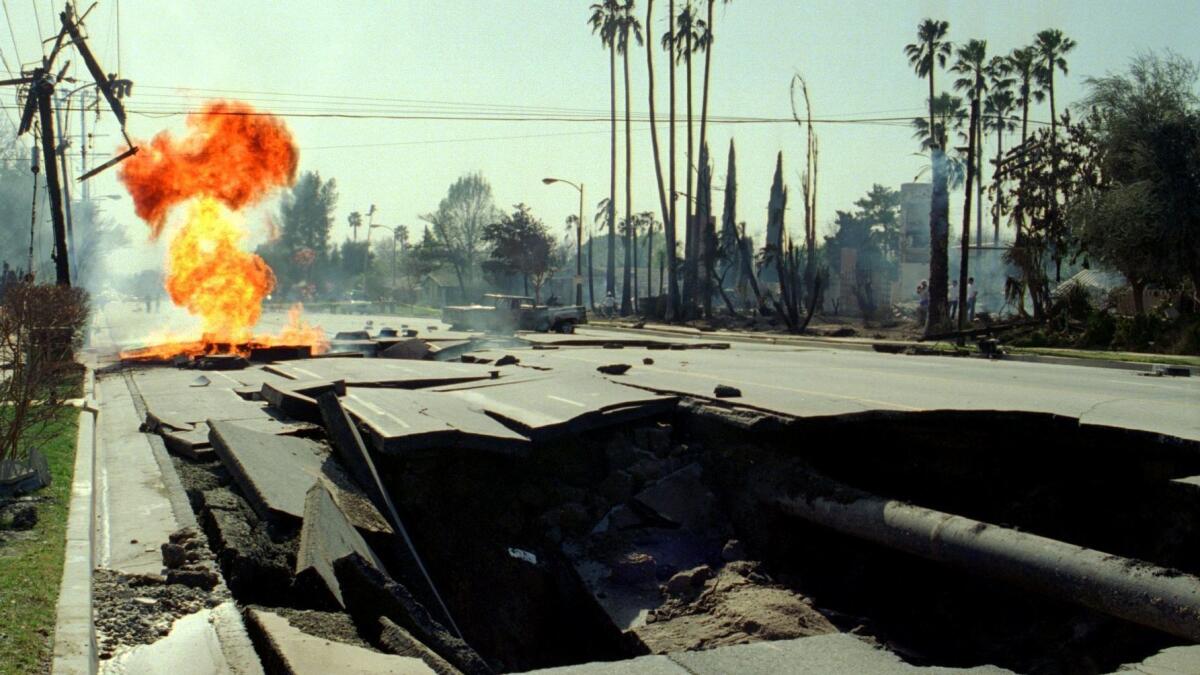Column: Every California family has an earthquake story. Mine is embarrassing but true

- Share via
Every Californian who makes it through an earthquake unscathed has a favorite story.
Mine is a family story. It stems from the deadly Sylmar earthquake, which struck Los Angeles on Feb. 9, 1971.
I was 15 years old, a sophomore at Cleveland High School, the second of four kids. This was before everybody’s parents started getting divorced, so our family of six was still intact.
We were all asleep in Northridge when the magnitude 6.6 temblor began at 6 a.m.
My older sister and I, who shared a bedroom, leapt out of bed and ran to the flagstone entry of our ranch-style house to join our parents, who’d also been shaken awake.
This was a terrible quake; at least 64 people would die, most of them patients at two hospitals that collapsed in the northern San Fernando Valley. About 2,500 more were injured.
The Van Norman Dam, between Granada Hills and Sylmar, was also in danger of failing. A flood would have caused thousands of deaths. We spent the day on higher ground, with friends in Chatsworth, until the danger passed.
Massive earthquakes cracked the very foundations of the tiny but tough town of Trona »
On the morning of the quake, after the shaking stopped, we heard bloodcurdling screams coming from the other side of the house. It was our little sister, whose bedroom was past the kitchen, through the laundry room. It was the “maid’s room.” If this sounds snooty, it wasn’t. In 1970, the house had cost $39,000. My parents bought it on my father’s salary as a professor at Cal State Northridge. We never, ever had a housekeeper.
Anyway, as my little sister shrieked, the chaos was compounded by my reaction to the shocking event: I crumpled to the ground.
As it happens, losing consciousness is a family trait. One of my friends calls us “the fainting goats.” Members of my clan have passed out after suffering physical pain, or getting too high, or feeling terrified. I once passed out after falling out of a hammock.
This time, I was lucky. My hair was in rollers, which cushioned my head against the flagstones.
And so, I have become the star — well, the butt — of our family’s favorite quake story.
“We all looked around for Robin,” my father says. “And she wasn’t there.”
On Friday, the night of the 7.1 Ridgecrest quake, I was far away in the mountains of southern Colorado. However, I have it on good authority that my family’s favorite earthquake story did not go unmentioned during dinner in Venice.
Thank you for thinking of me, Dad.
::
We really knew less than nothing back then about earthquake preparedness.
We did not have a kit of any kind, nor extra water, food or cash.
Lucy Jones didn’t feel the 7.1 earthquake but helped the world understand it »
Shamefully, 23 years later, I still did not have a kit, when the magnitude 6.7 Northridge earthquake struck, killing 57 people. Sixteen people who lived on the ground floor of the Northridge Meadows apartments died when the building collapsed on them. A police officer rushing to emergency duty perished when his motorcycle plunged off a collapsed section of freeway.
By this time, I was married and living on a Venice walk street near Lincoln Boulevard. Again, I leapt out of bed when the house began to shudder.
But now, I was a parent, and my fear was for my toddler, who slept peacefully through the bumping and rolling, and for my 90-year-old grandmother, who was in a Mission Hills retirement home very close to the epicenter.
My mother, who lived in Hollywood, had warned me not to buy a house in Venice: “It’s liquefaction territory,” she said darkly.
I had no idea what she was talking about; the word conjured an image of quicksand, of ground turning to slush, of the house sinking into the earth. Turns out, this is exactly what can happen when a quake liquefies the ground.
Our house in Venice came through unscathed, but there was unexpected wreckage next door in Santa Monica, which had a lot of “soft story” apartments, buildings with flimsy ground-level car ports supporting living units, pancaked all over the place. Roughly 1,500 units were lost.
In the Valley, there was destruction the likes of which I had never seen: On my way to bring my grandmother back over the hill to stay with us, I drove past piles of masonry and glass on sidewalks. Parking structures had collapsed. I passed a four-story building under construction whose metal window frames had twisted away from the building.
Broken gas mains leaked. Balboa Boulevard caught fire.
Two stretches of the Santa Monica Freeway — at Washington and La Cienega boulevards — had collapsed. Until the repairs were completed less than three months later, getting downtown from the Westside involved a Mr. Toad’s Wild Ride of a freeway detour that I miss to this day.
Ridgecrest earthquake shattered California’s cool »
Last year, uncharacteristically, I ordered an earthquake kit.
On Sunday, I intended to make sure it was up to date, to buy more water, to add some cash.
But the sun was out, the beach was calling. I got busy and forgot.
I’ll get to it next weekend, or maybe the weekend after.
When I do, I’m thinking about adding some smelling salts.
Just in case.
Twitter: @AbcarianLAT
More to Read
Sign up for Essential California
The most important California stories and recommendations in your inbox every morning.
You may occasionally receive promotional content from the Los Angeles Times.











